
Join a star-studded roundtable of Fear Free experts discussing the interaction of pain and fear, how the variability between specific patients and species can affect pain, and how management of fear can help to alleviate pain.

Join a star-studded roundtable of Fear Free experts discussing the interaction of pain and fear, how the variability between specific patients and species can affect pain, and how management of fear can help to alleviate pain.
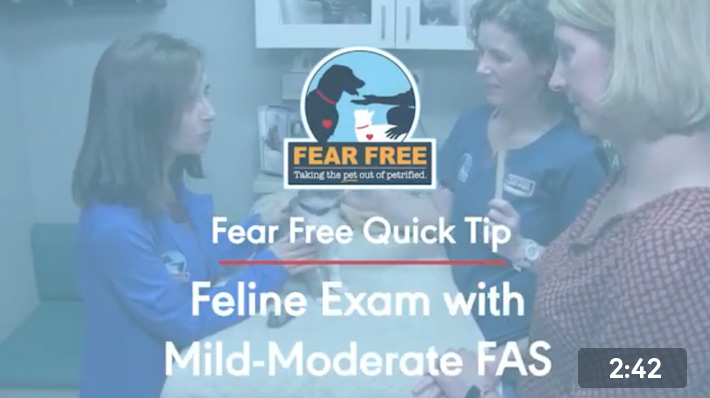
You must be a Fear Free member to access this content.
Lisa Radosta, DVM, DACVB, shows how to examine a feline patient who is exhibiting mild to moderate FAS in a safe and controlled manner.

Debbie Martin, RVT, CPDT-KA, KPA CTP, VTS (Behavior), demonstrates how you can help coach your clients to get their dogs on the scale easily and without stress.
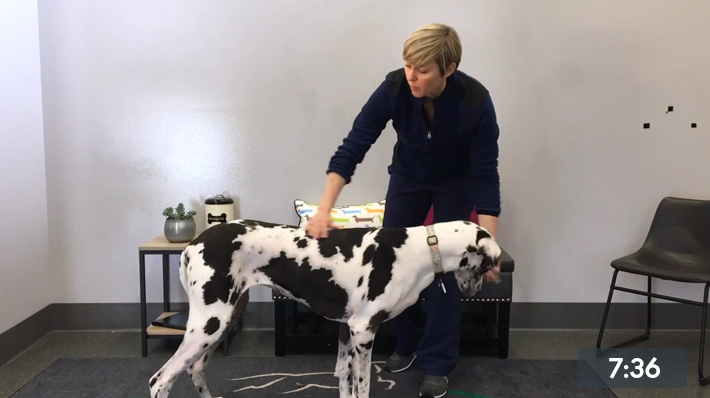
[wcm_restrict plans=”level-1-group-leader, certified-practice, groomer-certification, animal-trainer, student, sitter-certification-program, boarding-daycare-certification-program”]
Kristin Kirkby Shaw, DVM, MS, PhD, DACVS-SA, shows you how to perform a one-minute orthopedic exam on a dog utilizing Fear Free principles. For a more detailed exam, you can view an extended video here.
[/wcm_restrict]
[wcm_nonmember plans=”level-1-group-leader, certified-practice, groomer-certification, animal-trainer, student, sitter-certification-program, boarding-daycare-certification-program”]
[/wcm_nonmember]
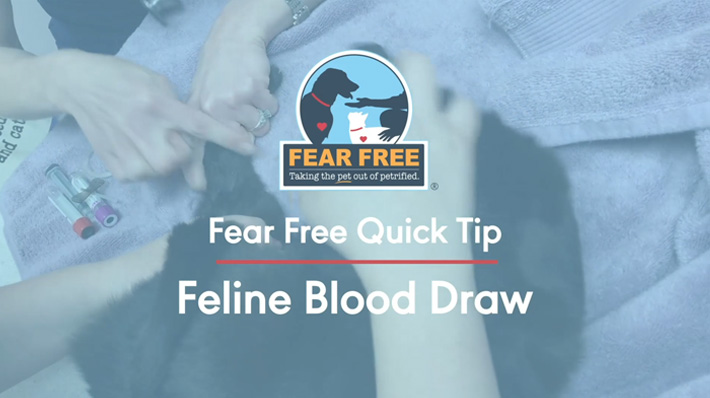
Feline blood draws are often stressful for the professional, and even more so for the patient. Veterinary technician/trainer Tabitha Kucera, CCBC, RVT, KPA-CTP, shows how you can get a blood draw done on a feline patient quickly, easily, and, most importantly, Fear Free.
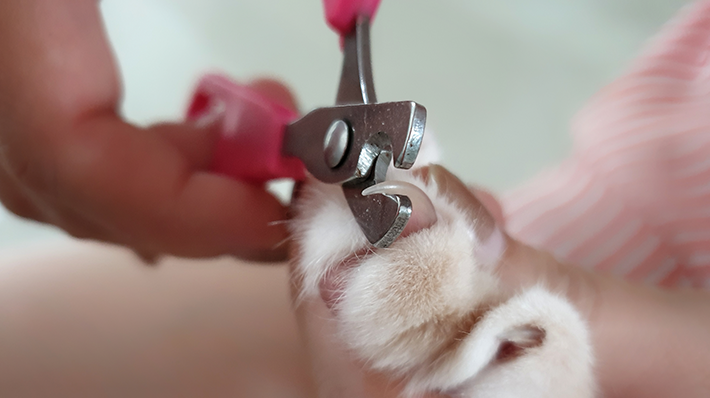

I have been doing nail trims and anal sac expressions in my neighborhood for the last three years. Recently, one of my neighbors had asked on our community Facebook page if someone in the veterinary field could answer a question. Her dog was limping, and she didn’t know what to do. One of the neighbors offered her some doggy aspirin she had bought at the pet store. I quickly advised against giving unprescribed medications to her pet.
The conversation turned into a bullying session. One of my neighbors told me I shouldn’t try to act like a veterinarian. I have never felt so disrespected in the 15 years I have been in this career.
I shut down.
The next thing I knew, I was in my closet, crying, repeating to myself, “I don’t care, I don’t care anymore. Why should I care about others’ pets if I am going to be treated like crap? I’m done.”
I may have been improving with burnout, but I had just hit a whole new level of compassion fatigue.
I had a full weekend’s worth of nail trims to do and was going to make a little more than $200 in five hours. I didn’t care about the extra money anymore and canceled all appointments for the foreseeable future.
In tears, I explained to my husband why I had given up making extra money on the side. It was clear he wanted to help but didn’t know what to say or do. I knew I needed professional help.
Now I’m in the process of finding a therapist I can connect with. Until then, my family and I have adopted the following tools to help reduce stress:
–Simple Habit, a meditation app. My son uses it to fall asleep and settle down. He will ask to meditate to go to sleep now.
–A “coming home” routine: The spouse who is home first allows the second spouse to “finish coming home.” This gives them some quiet transition time to put their bags down, change clothes, and relax. When they’re ready to engage with the other spouse to prepare for the evening, they come out of the bedroom or wherever they choose to decompress.
–Boundaries with kids: I explain to my son that I need time to talk with his dad and ask him to sit quietly and watch a short show or play ABCmouse, a reading app. I also set timers in the house called, “Time to get ready for bed,” “Time for bed,” and “Quiet time is over.”
–Communication: When I start to feel like I’m getting anxious, I communicate how I am feeling and what I need to be able to come back down to earth.
Most of all, we continue to remind each other to slow down, be present, engage, and take time to listen to one another. My husband and I are working to improve our communication with our 3-year-old son so we can help him become an emotionally intelligent person, something his dad and I still work on ourselves.
We make time to have difficult conversations, and when we get into arguments, we try to make it a conversation, being mindful of raised voices, body language, and facial expressions. When necessary, we call each other out in a respectful way, in the moment, to help the other become aware of what they are doing.
The Fear Free way of thinking has helped me in so many aspects of my life. I use the techniques with my own son when he has doctor appointments as well as in everyday life. I communicate with him, making sure he knows what is coming up next, where we are going, what the doctor will do next. He is better behaved and calmer when things are explained to him, in most settings. I think that most children would respond to situations in a calmer manner when a Fear Free or Considerate Approach is taken.
In a work setting, my current team is emotionally intelligent, and all know the battle that I am fighting, which helps. Openly discussing things with your team can not only help you to become stronger but also to be seen with more respect and empathy than if you suffer in silence to spare everyone else’s feelings. Maybe someone on your team is suffering as well and doesn’t have the courage to speak up. Sharing your battles may give them strength to seek help for theirs. I wish more practice managers and owners would spend a day, at least, in a Fear Free certified hospital.
The most important message I want to send is that the battle of burnout is ongoing, and it’s not one you can win on your own. It doesn’t fix itself overnight or with a couple of therapy sessions.
Here is a quote I read frequently from Rachel Ashwell’s book “Painted Stories”:
“There is a time for taking action and creating work, and there is also a time for rest and seeking new ideas. Learning when you need space will help you to build a more sustainable creative practice.”
Check out our Fear Free on the House page for resources on wellness, quick tips, and more!
This article was reviewed/edited by board-certified veterinary behaviorist Dr. Kenneth Martin and/or veterinary technician specialist in behavior Debbie Martin, LVT.
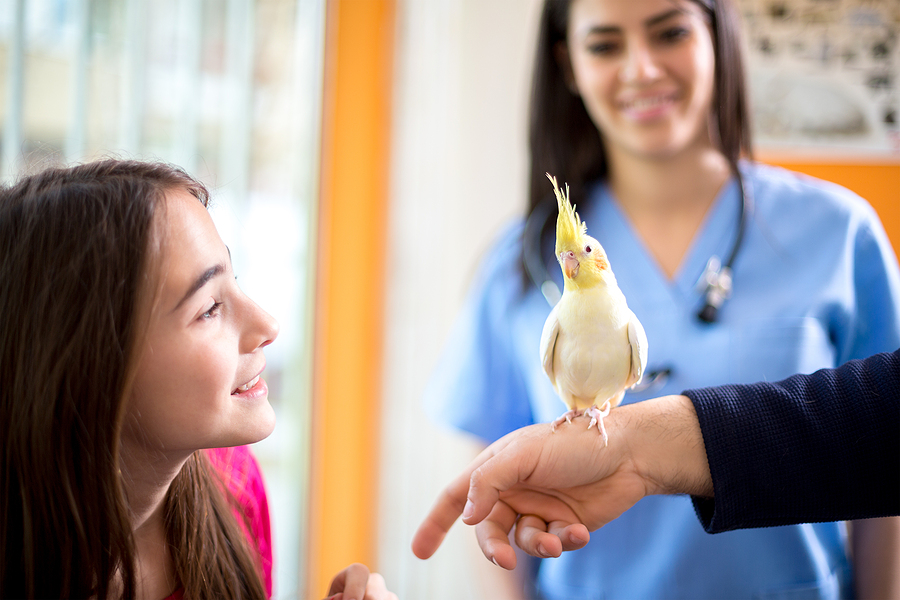
But what happens when things do not go as planned? What if expectations are too high and the pet obtained is unable to live up to the client’s expectations? Biting, screaming, and feather picking are parrot behaviors that many new owners are not prepared for when they acquire their pet. In the avian world, euthanasia is much less likely as most veterinarians are hesitant to end a bird’s life due to the client’s convenience, but this makes it more likely that the bird will be rehomed multiple times.
What if we were able to prepare our avian clients for behavioral problems before they start? What if avian rescues could work to teach birds specific cued behaviors to help eliminate aggression in some of these pets?
Psittacine preparatory programs or avian prep programs can be life-changing for birds and a great resource for owners to understand normal bird behavior, create realistic long-term expectations, and work toward creating an environment that is mentally and behaviorally enriching. They also help teach cued foundation behaviors used to eliminate and replace unwanted behaviors (just as we do with dogs and cats). Avian prep programs can help to strengthen the human-animal bond, keep birds in a home long-term, and increase the bond between client, bird, and clinic. Bonus: offering such programs also increases revenue through fees and the sale of products and treats.
Who will teach the courses? What are the most important topics to teach? What foundation behaviors are most important and why? These are all great questions and we will break them down below:
Educator/Instructor: An avian veterinarian or veterinary technician with a special interest in birds should instruct this course. The individual should be knowledgeable in avian communication, body language, forms of enrichment, and use of positive reinforcement for training. An exotic-animal trainer may be an ideal instructor if one is in your area. This trainer should use and recommend positive reinforcement. Avoid use of aversive training techniques, which can increase fear, stress, and anxiety in all species.
I recommend creating a four-week course. The first two weeks can be taught virtually or in person without the client’s bird present. The goal in the first two weeks will be to review the basics of avian communication, enrichment and environmental set up, learning theory and use of positive reinforcement (with a marker), and answer client questions. The third and fourth classes will focus on teaching cued behaviors with the birds present in the hospital. (See the chart below)
To prevent potential disease transmission or other risks for birds brought to class, take the following measures:
| Class | Topic and Discussion Points |
| Class One (Humans Only) | · Introduction and Client Problem Behavior Discussion (Why are they here and what are they seeing at home?)· Avian Communication
· Environmental Enrichment/Management |
| Class Two (Humans Only) | · Environmental Enrichment/Management (cont.)· Learning Theory and Using Marker Training
· Marker Mechanics and Preparing for Birds in Class |
| Class Three (Humans and Birds) | Break down into 5- to 10-minute training sessions with short breaks in between.· Name Orientation
· Target · Step to Me · Off · Station Training |
| Class Four (Humans and Birds) | Break down into 5- to 10-minute training sessions with short breaks in between.· Name Orientation
· Target · Step to Me · Off · Station Training |
The following behaviors can be useful to have trained and generalized prior to problem behaviors starting. Response Substitution is a term used when we want to replace an unwanted behavior with a new behavior. Teaching and creating strong cued behaviors can help to eliminate and give alternative responses in situations involving attention-seeking or aggression.
Name Orientation: Teaching birds their name can help with obtaining their attention to interrupt unwanted behaviors and ask them to offer a different behavior.
Target Training: This behavior can be used to teach the bird to move from one place to another by teaching them to place their beak near the target.
Step to Me: Cue a bird to move to handler’s arm or hand to be transported from one place to another.
Off: Cue bird to move off of handler during periods where conflict may occur.
Station Training: Teach bird to go to a specific location on cue. This can be used as an alternative behavior.
Avian prep programs and training classes are currently scarce but ideally courses like this will become as routine as dog training classes. Pet birds deserve just as much of a chance to be successful in the home environment as dogs or cats. If you or others you know are teaching a course like this, please update us on the Fear Free for Professionals Facebook Group. We would love to see your photos and ideas for these courses as well as your feedback!
Resources
Luescher, Andrew. Manual of Parrot Behavior. Blackwell Publishing. 2006
Shaw, Julie K. and Martin, Debbie. Canine and Feline Behavior for Veterinary Technicians and Nurses. Wiley & Sons, Inc. 2015.
This article was reviewed/edited by board-certified veterinary behaviorist Dr. Kenneth Martin and/or veterinary technician specialist in behavior Debbie Martin, LVT.

In part due to the excellent veterinary care that we deliver to our patients, we are presented with more geriatric cats and dogs now than we were 10 years ago. Most of us didn’t learn much about how to recognize and treat cognitive dysfunction syndrome (CDS) in dogs and cats. In this session, attendees will learn the most up to date prevention strategies and treatments of CDS in dogs and cats.
In this webinar, Lisa Radosta, DVM, DACVB, will cover:
1. The most common clinical signs of CDS
2. The most commonly used treatments
3. How non-medical treatments can be effective in the management of CDS patients
About the Presenter
Lisa Radosta, DVM, DACVB, graduated from the University of Florida College of Veterinary Medicine in 2000. After completing an internship in small animal medicine and surgery at Coral Springs Animal Hospital, she worked as a primary care veterinarian for two and a half years. She completed a three-year residency in behavioral medicine at the University of Pennsylvania in 2006 and passed the board examination later that year. During her residency, she received the Resident Research Award from the American College of Veterinary Behaviorists (ACVB) two years in a row.
Dr. Radosta lectures nationally and internationally for veterinary professionals and pet owners and is the author of a number of textbook chapters and scientific research articles, She also co-authored “From Fearful to Fear Free: A Positive Program to Free Your Dog from Anxiety, Fears, and Phobias” with Dr. Marty Becker, Mikkel Becker, and Wailani Sung.
She is the section editor for Advances in Small Animal Medicine and Surgery and served on the 2015 AAHA Canine and Feline Behavior Management Guidelines Task Force.
This webinar is brought to you by our friends at Zoetis Petcare.
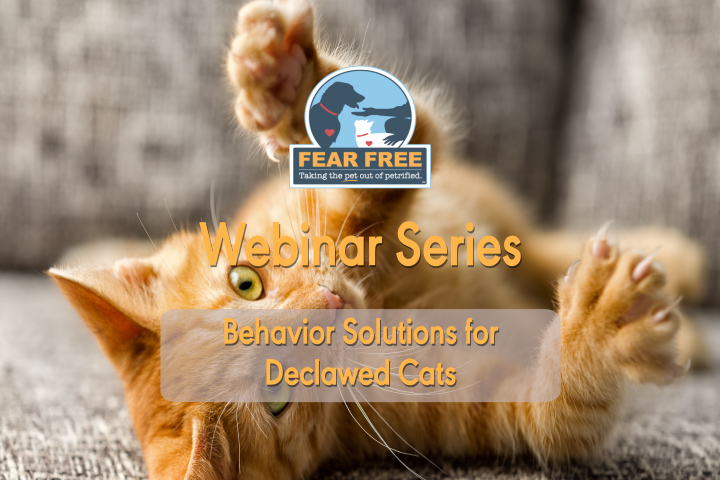
Behavior Solutions for Declawed Cats with Dr. Lisa Radosta
An important part of setting a declawed cat up for successful life at home is understanding and molding their behavior. Join Lisa Radosta, DVM, DACVB, a leader in behavior and a member of the Fear Free Advisory Team, as she discusses behavioral solutions for declawed cats to help reduce their fear, anxiety, and stress both at the clinic and at home.
About the Presenter
Lisa Radosta, DVM, DACVB, graduated from the University of Florida College of Veterinary Medicine in 2000. After completing an internship in small animal medicine and surgery at Coral Springs Animal Hospital, she worked as a primary care veterinarian for two and a half years. She completed a three-year residency in behavioral medicine at the University of Pennsylvania in 2006 and passed the board examination later that year. During her residency, she received the Resident Research Award from the American College of Veterinary Behaviorists (ACVB) two years in a row.
Dr. Radosta lectures nationally and internationally for veterinary professionals and pet owners and is the author of a number of textbook chapters and scientific research articles, She also co-authored “From Fearful to Fear Free: A Positive Program to Free Your Dog from Anxiety, Fears, and Phobias” with Dr. Marty Becker, Mikkel Becker, and Wailani Sung.
She is the section editor for Advances in Small Animal Medicine and Surgery and served on the 2015 AAHA Canine and Feline Behavior Management Guidelines Task Force.